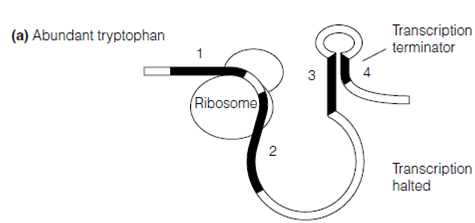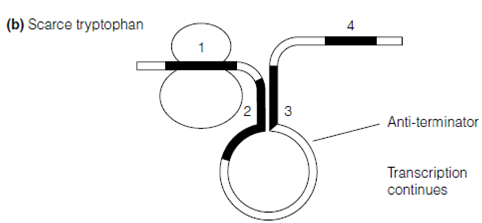Attenuation:
The second mechanism is known as attenuation. It is also used to control expression of the trp operon. The five end of the polycistronic mRNA transcribed from the trp operon has a leader sequence upstream of the coding region of the trpE structural gene shown in the figure. This leader sequence instructs a 14 amino acid leader peptide containing two tryptophan residues.
The method of the leader sequence is to good tune expression of the trp operon based on the availability of tryptophan inside the cell. It does this as bellows. The leader sequence holds four regions which can form a variety of base paired stem-loop 'hairpin' secondary structures. Let consider now, the two extreme conditions: the absence or presence of tryptophan. Attenuation depends on the fact in which, in bacteria, ribosomes attach to mRNA as it is being synthesized and so translation begins even before transcription of the overall mRNA is complete. When the tryptophan is abundant which is shown in the above figure, ribosomes bind to the trp polycistronic mRNA which is being transcribed and start to translate the leader sequence. Recently , the two trp codons for the leader peptide lie within sequence 1 and the translational Stop codon lies among sequence 1 or 2. In During translation the ribosomes follow very closely behind the RNA polymerase and synthesize the leader peptide with translation stopping eventually among sequences 1 or 2. At this point the position of the ribosome avoid sequence 2 from interacting with sequence 3. Alternatively sequence 3 base pairs with sequence 4 to form a 3:4 stem loop that acts as a transcription terminator.


Figure: Attenuation of the trp operon. (a) When tryptophan is plentiful, sequences 3 and 4 base pair to form a 3:4 structure that stops transcription (b) when tryptophan is in short supply, the ribosome stalls at the trp codons in sequence 1, leaving sequence 2 available to interact with sequence 3. Thus a 3:4 transcription terminator structure cannot form and transcription continues.
Thus, when tryptophan is available, further transcription of the trp operon is prevented. If, moreover, tryptophan is in short supply in the figure, the ribosome will pause at the two trp codons contained within sequence 1. This will leaves sequence 2 free to base pair with sequence 3 to form a 2:3 structure also known as the anti-terminator, so the 3:4 structure cannot form and transcription continues to the end of the trp operon because the availability of tryptophan controls whether transcription of this operon will stop early (attenuation) or continue to synthesize a complete polycistronic mRNA.
Previously, attenuation was invented when it was noticed which deletion of a short sequence of DNA among the operator and the first structural gene, trpE, raise the level of transcription. This region was named the attenuator that is also shown in the figure and is the DNA which encodes that element of the leader sequence which forms the transcription terminator stem-loop.